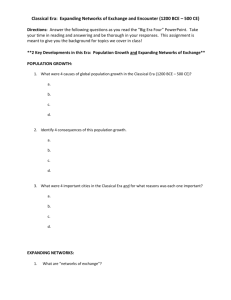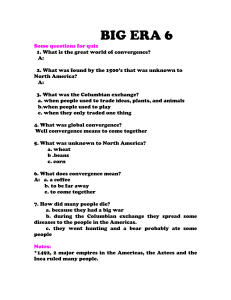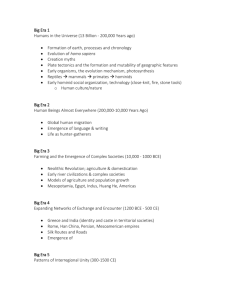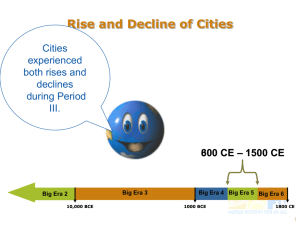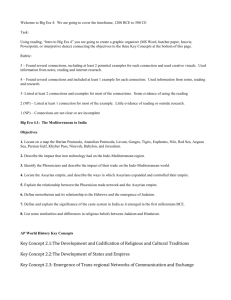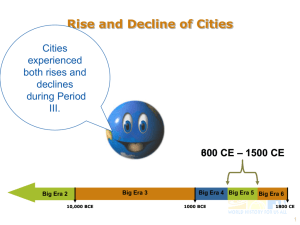File - Mr. Buffa
advertisement
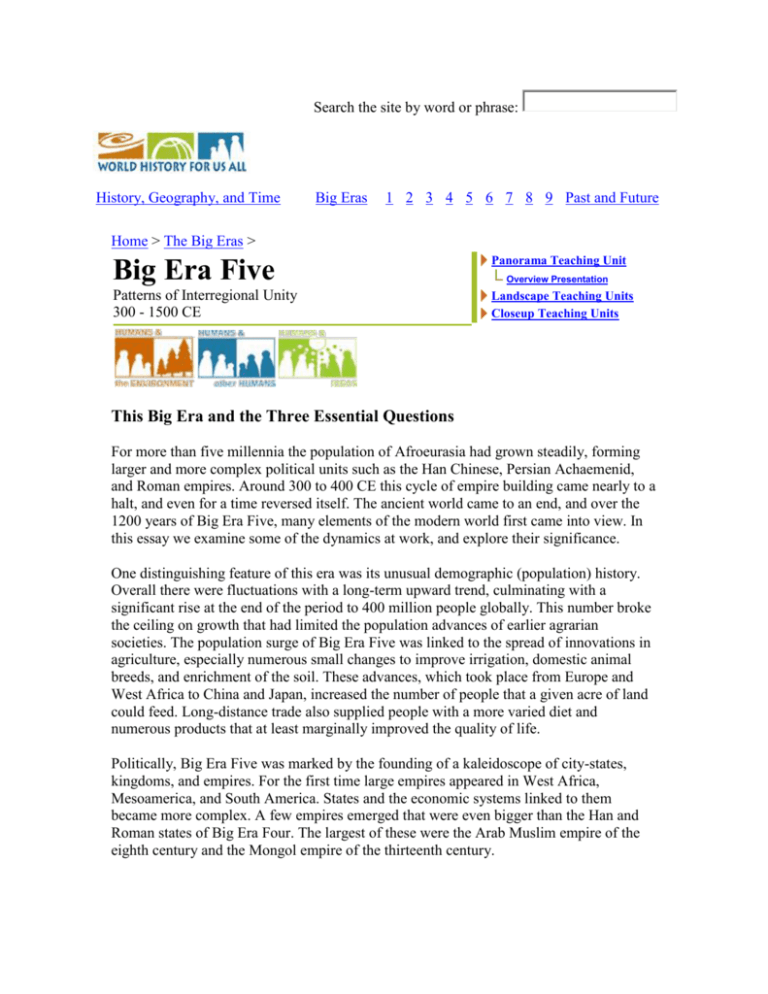
Search the site by word or phrase: History, Geography, and Time Big Eras 1 2 3 4 5 6 7 8 9 Past and Future Home > The Big Eras > Big Era Five Panorama Teaching Unit Patterns of Interregional Unity 300 - 1500 CE Landscape Teaching Units Closeup Teaching Units Overview Presentation This Big Era and the Three Essential Questions For more than five millennia the population of Afroeurasia had grown steadily, forming larger and more complex political units such as the Han Chinese, Persian Achaemenid, and Roman empires. Around 300 to 400 CE this cycle of empire building came nearly to a halt, and even for a time reversed itself. The ancient world came to an end, and over the 1200 years of Big Era Five, many elements of the modern world first came into view. In this essay we examine some of the dynamics at work, and explore their significance. One distinguishing feature of this era was its unusual demographic (population) history. Overall there were fluctuations with a long-term upward trend, culminating with a significant rise at the end of the period to 400 million people globally. This number broke the ceiling on growth that had limited the population advances of earlier agrarian societies. The population surge of Big Era Five was linked to the spread of innovations in agriculture, especially numerous small changes to improve irrigation, domestic animal breeds, and enrichment of the soil. These advances, which took place from Europe and West Africa to China and Japan, increased the number of people that a given acre of land could feed. Long-distance trade also supplied people with a more varied diet and numerous products that at least marginally improved the quality of life. Politically, Big Era Five was marked by the founding of a kaleidoscope of city-states, kingdoms, and empires. For the first time large empires appeared in West Africa, Mesoamerica, and South America. States and the economic systems linked to them became more complex. A few empires emerged that were even bigger than the Han and Roman states of Big Era Four. The largest of these were the Arab Muslim empire of the eighth century and the Mongol empire of the thirteenth century. Long-distance commerce grew and cities multiplied across Afroeurasia, especially between 1000 and 1500 CE. Big Era Five saw the emergence of the Indian Ocean basin as a new focus of busy economic interchange. Notably during the era of the Mongol empire and the several big Mongol states that followed it, the silk roads across Afroeurasia bustled with caravan trade in silks, cottons, spices, tea, horses, ceramic wares, and numerous other products. Caravans and ships also carried ideas; during this era, a great deal of scientific and technological cross-fertilization took place, especially in Afroeurasia but also in the Americas. In America, artistic and architectural techniques and styles spread from the Olmec city-states of the second and first millennium BCE far and wide across Mesoamerica and to Native American peoples farther north. Culturally, Big Era Five featured the consolidation of several belief systems and the continuing retreat of the purely local religions of farmers, foragers, and pastoral nomads. The number of distinct religious traditions in the world almost certainly declined significantly, even as universalist religions, that is, those that appealed to people across boundaries of language and local culture, grew by leaps and bounds. Islam, the last of the major world belief systems, emerged in the seventh century CE. Islam, together with Christianity and Buddhism, offered a universal message of comfort, moral living, and salvation that gave them widespread appeal. Not all individuals and societies benefited equally—or benefited at all—from these trends in political, economic, and cultural growth. Millions fell victim to conquests, millions more paid heavy taxes to authoritarian rulers, and slavery continued to thrive. Nevertheless, an array of ingenious technological advances allowed humankind to feed, clothe, and shelter itself even as global population grew faster than in any earlier era. Humans and the Environment Big Era Five began with a sharp population decline that lasted from the third to the sixth centuries CE and that affected large areas of Afroeurasia. We do not entirely understand why this demographic downturn occurred, but it is likely associated with a number of factors. One was a cycle of climatic change that produced drier conditions and consequently declines in agricultural productivity, notably in irrigated river valleys. Another was outbreaks of infectious disease epidemics. The one that hit the Mediterranean region in the sixth century is known as Justinian's Plague after the famous Roman emperor of that period. Economic recession and epidemics disrupted established empires and states across Afroeurasia, and this helped open agrarian societies to recurring invasions and migrations of pastoral nomadic peoples from the Inner Eurasian steppes. By the sixth century CE, however, the overall population of Afroeurasia started to rise again. But this time it kept on going for more than 700 years. By around 1250 CE global population reached about 235 million. Then, in the early fourteenth century, a series of hemispheric-wide disease epidemics, especially the Black Death of mid-century, intervened to reduce the population of Eurasia and North Africa by a quarter to a third. The onset of a cycle of lower temperatures in the Northern Hemisphere, what historians call the Little Ice Age, also contributed to agricultural depression and declining population, especially in Europe, Russia, and China, and probably also in North America. This demographic setback, however, did not last long. By 1500 world population had surpassed all previous levels, reaching 400 million.1 Population, Agriculture, and Trade Why did world population start moving up faster toward the end of Big Era Five? One factor is that continuing improvements in farming technology increased the productivity of the land, allowing food supplies to run ahead of population growth. By 1500 CE, states and empires were able to feed and clothe more people, build larger armies, and accumulate much more tax revenue to enhance their power. Better agriculture evolved from centuries of identifying the best techniques, seeds, and strategies of farming in particular regions from which these ideas spread across Afroeurasia by the trade routes. In northern Europe, for example, the moldboard plow and the horse collar were inventions that enabled European peasants to cultivate heavy wet soils and open immense new areas to farming. This led to significant population increases. In India, the opening of the vast delta of the Ganges valley to rice cultivation allowed large population growth in Bengal. Similar patterns of improvement can be seen in the Americas. For example, expertise in breeding and growing corn, beans, and squash first developed under the Olmecs, then spread throughout much of North America, sustaining towns, cities, and empires. More intensive commercial exchange and movements of peoples across Afroeurasia by land and sea during Big Era Five also helped stimulate population growth. On land, the rise of great empires that originated among pastoral peoples—the Huns, Arabs, Turks, and Mongols—was made possible by technological developments that enabled these peoples to better exploit the steppe and desert lands they inhabited. In the area of transport and war-making, these advances included the invention of the stirrup and the North Arabian camel saddle, which made riding on horses or camels a much more stable experience. For more than a millennium, pastoralists, especially Turkish-speaking horse nomads and Arabic-speaking camel nomads, were the world leaders in mounted warfare. (The Americas had neither horses nor camels until after 1500 CE.) The rise of pastoral power was accompanied by increased volume and complexity of trade across Afroeurasia's Great Arid Zone, the belt of dry country that extends from western Africa to northern China. Also in this era, the trans-Saharan trade in gold, salt, and other commodities stimulated growth of population and cities north and south of the desert, as well as cultural exchange, notably the Islamic faith, between the Mediterranean lands and West Africa. Astrolabe attributed to Ahmad ibn muhammad al-Naqqash, dated to Zaragoza, Spain in the eleventh century CE. Wikimedia Commons In the seas of Afroeurasia from the Mediterranean to the China seas, new ship construction, sailing, and navigational techniques greatly stimulated the circulation of goods, people, and ideas across maritime Eurasia. Key inventions included the compass, the stern post ship rudder, the astrolabe, and the fore-and-aft, triangle-shaped lateen sail. The techniques of banking and business organization also became more sophisticated. By 1500, the societies of both island Southeast Asia and coastal East Africa were becoming increasingly integrated into the wider Afroeurasian intercommunicating zone. The Indian Ocean emerged as a major new arena of world trade to rival the Mediterranean. In spite of these long trends of growth in populati German illustration of the three on, estates of medieval society, with producti peasants making up the lowest on, and third. trade, all parts of Wikimedia Commons the world remaine d suscepti ble to war, flood, famine, and disease, events that could suddenly interrupt a trend of economic and population growth. If farmers and herders stopped producing more because of some unforeseen crisis, then population growth came to a halt or numbers even went down, as the era of the Black Death grimly demonstrated. We should remember that human beings still depended on the energy of the sun, with a little help from windmills, water wheels, and sail craft, to produce all food, textiles, and other products. The “ fossil fuel revolution," which unleashed the vast energy power of coal, petroleum, and natural gas, lay several centuries in the future. Environmental Problems Amid the growth and prosperity of Big Era Five, there was also a strong countercurrent: a sharp global increase in environmental degradation. Historians have documented the environmental impact of state-building, urbanization, and commercial expansion on the Byzantine empire, the Muslim empires of Southwest Asia and North Africa, and the empires of South and East Asia. In particular, deforestation increased, provoking longterm soil erosion and frequent flooding. There were also growing wood shortages owing to the accelerating demand for wood energy for domestic fires, brewing, dyeing, metallurgy, and other industrial uses, as well as dependence upon wood as the primary material for constructing buildings and ships. For example, at the start of Big Era Five, forest clearing in Roman Italy caused irreversible soil degradation and contributed to serious food shortages. In China, deforestation that accompanied urbanization and economic expansion contributed to river flooding, which devastated villages and farmlands. The incidence of flooding on China's major rivers appears to have increased steadily in Big Era Five. Despite important fluctuations in this period, by 1500 CE populations had clearly surpassed previous levels around the world. Advances in agriculture and commerce enabled humans to push beyond previous population levels and to bring more regions into sustained contact with one another. Humans and Other Humans Big Era Five marks the apex of pastoral power across Afroeurasia. Since Big Era Four, pastoral nomads had constituted a serious challenge to settled societies and agrarian empires across the region. Beginning in the fourth century CE, armed invasions perpetrated by Uighurs, Huns, Arabs, and other mounted armies, plus the spread of epidemic disease, seriously weakened several agrarian empires. The western Roman empire totally collapsed. A recovery then ensued. The period starting in the fifth century CE witnessed the rise of the Gupta empire in India, the Arab empires in west central Afroeurasia, and the Tang and Sung empires in China. These states were undermined, however, by the eleventh or twelfth centuries owing to large-scale Turkic and Mongol migrations. The Mongol conquest from 1206 to 1260 created an empire that stretched from Korea to eastern Europe. Under Chingis Khan (Genghis Khan) and his successors, the Mongol state at its height around 1260 controlled a territory of close to 7 million square miles, making it the largest empire in human history. In Europe, the Byzantine empire and the early Russian empire came to flower in Big Era Five, while in Africa south of the Sahara a number of important states emerged, among them Ghana and Mali in West Africa and Great Zimbabwe in southern Africa. From about the seventh century, city-states whose merchant populations were predominantly Muslim flourished along the East African coast, shipping gold, ivory, and numerous other products to the wider Indian Ocean world. In Southeast Asia, several maritime empires emerged, for example, Srivijaya and Majapahit, which drew great wealth from trade in spices. In the Americas, the Aztec and Incan territorial empires, which emerged late in this era, bear comparison to those of Afroeurasia. The comparisons below show the remarkable scale of the Arab Muslim and Mongol states. On the other hand, neither state lasted as a unified empire more than about half a century. The outer areas of the Arab Muslim empire soon broke away from the central lands. In the Mongol case, Chingis Khan's sons and grandsons launched wars against one another within about thirty years of the great conqueror's death. Those struggles led to the dismemberment of the realm into four Mongol-ruled monarchies.2 State Approx. Year Approx. size in square miles Roman empire 100 C.E. 1,698,400 Arab Muslim empire 750 C.E. 4,246,000 Sung empire (China) 1000 C.E. 1,158,000 Mongol empire 1250 C.E. 6,948,000 Inca empire (Andes Mts.) 1500 C.E. 772,000 Continental United States Present 3,021,000 The Scale of Warfare In Big Era Five, warfare reached new levels of violence, thanks to the widespread use of projectile weapons, such as the catapult, the long bow, the compound bow, and the crossbow. Chinese armies first deployed gunpowder weapons in the form of primitive cannons and muskets, but firearms soon spread to India, West Asia, the Mediterranean, and West Africa, and the technology continually improved. The ability to organize large armies linking cavalry and infantry in complex formations became developed further as well. The pastoral Arabs in the seventh and eighth centuries and the Mongols in the thirteenth century learned to combine cavalry warfare with the military techniques of agrarian empires, for example, the use of catapults and other siege weapons to breach the walls of cities. In the seas of Afroeurasia, naval warfare did not drastically change throughout most of this era. In the Mediterranean, sea battles featured clashes between large galleys rowed by dozens of oarsmen. But there were signs of change. Both the Byzantines and the Arabs started using "Greek fire," a petroleum-based substance, in naval encounters. More importantly, dramatic changes occurred in the navigation of the world's oceans. The widespread adoption of the compass and the stern post rudder increased the range and reliability of sailing along Afroeurasia's chain of seas. For example, colossal Chinese sailing vessels capable of carrying hundreds of sailors, merchants, and travelers over long distances appeared after 1000 CE. When the Chinese admiral Zheng-He visited Southeast Asia, India, Sri Lanka, the Persian Gulf, and the East African coast between 1405 and 1433, he had several ships that were 400 feet or more long and had five or more masts. In the northwestern Atlantic a completely different tradition of naval construction emerged by the fifteenth century. It brought together the fixed square sails of Mediterranean galleys and the triangular lateen sails of Arab feluccas and dhows. This rigging, together with stout hulls designed for the rough wind and sea conditions of the north Atlantic, led to the development of the caravel, the first proper ocean-going ship. By 1460, Portuguese and Spanish mariners had reconnoitered the western coast of Africa and discovered the Canary Islands. By the same date, Basque and French fishermen had pioneered new cod fishing grounds off the coast of Labrador and Newfoundland. Christopher Columbus drew heavily on the lore of these earlier mariners in planning westward the voyages that took him and his crew, not to East Asia as intended, but to the islands of the Caribbean. The Web of Commerce Despite the Mongol conquests and the Black Death in the thirteenth and fourteenth centuries, Afroeurasia experienced a general trend of economic growth from about 700 to 1500. China and India emerged as major manufacturing centers, their silks, porcelain china, and cotton fabrics circulating as far as East Africa and northern Europe. Southwest Asia, whose population became predominantly Muslim in the centuries after 700, served as the turnstile of the hemisphere. Its cities generated finished goods, and its bazaars and warehouses transshipped goods in large quantities from one part of the hemisphere to the other. Merchants traded over long distances both in manufactures and precious commodities— gold, gemstones, spices, silks, porcelain, glassware, ivory—and bulk products—grain, metal ore, fish, timber, bolts of textiles. This trade stimulated production in all regions that had tradable resources, and it tightened economic relationships among Afroeurasia's far-flung regions. As commerce grew, peoples of Japan, island Southeast Asia, equatorial Africa, and far northern Europe became increasingly linked into its web. For example, the state known as Great Zimbabwe rose to power in the savannas of southern Africa in the thirteenth century. Its prosperity derived partly from the sale of locally mined gold to merchants on the Indian Ocean coast, who traded this scarce commodity far and wide. Growth in production and commerce also stimulated more urbanization in both Afroeurasia and the Americas. By 1500, more humans lived in cities than ever before. There were more cities with populations of 200,000 or more, including Florence, Tenochtitlán, Istanbul, Delhi, and Cairo. The mega-city of them all was Hangzhou, with a population that exceeded one million. Understanding how extensive and sophisticated the trans-Afroeurasian exchange network had become by 1500 offers a fresh perspective on the next era, when Columbus and other intrepid mariners sailed across the Atlantic and Pacific oceans and around the Cape of Good Hope. When viewed against the background of steadily accumulating advances in transport and navigation and the thickening web of trade that crisscrossed Afroeurasia, it was almost certain that ocean-going mariners would eventually stumble upon the Americas. The Great Enclosur e at Great Zimbab we in southern Africa dates from the thirteent h to fifteenth centuries CE. Photo by Ross Dunn Humans and Ideas Two major cultural developments shaped Big Era Five. One was the consolidation of major belief systems, notably the rise and spread of the universalist religions of Christianity, Buddhism, and Islam. The other was the consolidation of scientific and technological traditions within particular complex societies and the diffusion of many new inventions and ideas across Afroeurasia. The Roman Catholic Cathedral in durham, England. Construction of this Norman Romanesque church began in 1087 CE Photo by Ross Dunn Major Belief Systems Among belief systems, Hellenism, that is, philosophical and scientific ideas expressed in the ancient Greek language, came to maturity in the first half of this era and spread widely. Hellenism provided an intellectual basis for applying human reasoning power to the problem of explaining nature and the cosmos. From about 500 BCE, Hellenistic thought deeply influenced intellectual and artistic life throughout the Mediterranean world, Southwest Asia, India, and Inner Eurasia. Starting in the eighth century, Muslim, Jewish, and Christian scholars in Baghdad and other Southwest Asian cities developed a new body of ideas, notably in mathematics, astronomy, philosophy, and medicine that synthesized and built upon Hellenistic, Persian, Mesopotamian, and Indian knowledge. In the later centuries of the era, European scholars adopted much of this Muslim synthesis and reconciled Hellenistic and Christian understandings of nature. The great Buddha carving in the Longmen caves in China dates from 672 CE. Photo by Ross Dunn The monotheistic religious traditions originating in Southwest Asia also developed and spread. Jewish monotheism, law, and ritual gradually linked dispersed Jewish communities all the way from the western Mediterranean to Inner Eurasia. Judaism was not a missionary religion but restricted to people born of Jewish mothers. The example of Jewish monotheism, however, laid spiritual and moral foundations for both Christianity and Islam. Christianity became dominant on the northern shores of the Mediterranean and throughout Europe during Big Era Five. By 1500, it became an important minority faith in Southwest Asia, Egypt, and Ethiopia as well as in parts of Inner Eurasia and Russia. The medieval Christian church in western Europe was headed by the Pope in Rome and linked under a hierarchy of bishops, priests, monks, and nuns. The Greek Patriarch in Constantinople presided over the branch of the Christian tradition known as Greek, or Eastern Orthodoxy. These two rival Christian churches split permanently in 1054 CE. In South Asia, Hinduism and Buddhism offered people possibilities of achieving one version or another of immortality, either through reincarnation, as in Hinduism and some forms of Buddhism, or through ethical devotion and right behavior. In East Asia, Confucianism stressed ethical righteousness, good government, and well-ordered society, while Daoism, and eventually Buddhism, emphasized the individual's quest for spiritual enlightenment. In the early centuries of the era, Christianity and Buddhism emerged as universalist religions, actively seeking to proclaim their message to all in the world who would listen, regardless of their ethnicity, language, or social status. Hinduism, which experienced a great resurgence in India relative to Buddhism during the Gupta empire of the fourth and fifth centuries, continued to be closely associated with Indian society and culture. It also enjoyed favor among some ruling groups in Southeast Asia. Similarly, the Daoist and Confucian belief systems remained deeply rooted in China but also developed influence in Korea and Vietnam. In China beginning with the Tang dynasty in the sixth century, the path to careers in scholarship and government was the imperial examination system, which rewarded those who demonstrated intricate knowledge of Confucian ethics and statecraft. While Buddhism declined in India, the land of its birth, it spread from India to China, Korea, Japan, and mainland Southeast Asia. Islam in the Tradition of Monotheism The emergence of Islam as a third universalist religion was the most dramatic development of this era. Islam was monotheistic, and it had a scripture (the Qur'an) and a Prophet (Muhammad). It preached the unity of God and the need to conform one's behavior to God's will, or risk eternal damnation. Like Christianity and Buddhism, but unlike Judaism, Islam was a missionary religion that by 1500 had spread outward from the Arabian Peninsula to India, Southeast Asia, China, Africa, and southern Europe. Under the early Muslim empires, especially the Abbasid dynasty (750–945) based in Baghdad, the caliphs, or rulers, drew heavily on the governing traditions of the Persian and Byzantine empires that preceded them. This included Hellenistic thought as well as the cultural heritage of India and Persia. In the tenth century, Turkic-speaking pastoralists of Inner Eurasia converted to Islam, giving Muslim societies a new vitality. After 1000 CE, Turkic warriors invaded and founded governments in all the territories between Egypt and northern India. In the early fourteenth century, Turkic horse soldiers laid the foundations of the Ottoman state, which became a major new eastern Mediterranean empire within a hundred years. The conversion to Islam of Berber-speaking pastoralists in North Africa and the Sahara in roughly the same period led to the founding of new Muslim states that stretched into Spain. It is significant that all the major religions of the era tended to thrive in and around cities and to spread along the major trade routes. This happened partly because organized religion tended to be closely linked with and supported by central governments, including large empires. Meanwhile, far from big cities and trade routes, people continued to practice local religions that often involved worship of gods and spirits associated with nature. A copy of the Buddhist text called the Pure Light Dharani Sutra. It dates from between 690 and 704 CE, when the Silla dynasty ruled Korea. It is an early piece of woodblock printing, in which individual sheets of paper were pressed into wooden blocks with text and illustrations carved into them, and ink applied. Photo by Ross Dunn In Big Era Five, indigeno us religions in the America s graduall y coalesce d into a smaller number of cultural tradition s. By the eve of the Spanish conquests in the Americas, the Maya and Aztecs in Mesoamerica and the Inca in South America had created large imperial religions that were in some respects comparable to those of Afroeurasia. In North America and in South America, other than in the Andes, more localized religious traditions were the rule. Science, Technology, and Learning The second major cultural development of this era was the diffusion of scientific and technological ideas along the land and sea trade routes. By 1500, scientific ideas and technological devices, such as writing systems, mathematics, celestial observation, water management, navigation, and mining were widely available among interconnected societies. For example, mathematics and astronomy became an area for broad interchange of ideas and techniques. The abacus and other counting techniques spread broadly around Afroeurasia. The mathematical concepts of zero, the base-ten numerical system, and use of the decimal point for positional notation spread from Buddhist learning centers in India, where they were developed about the fourth century, to Southwest Asia, North Africa, Europe, and China. Innovations like these provided the basis for arithmetic, advanced mathematics, and the calculations of the movements of celestial bodies as the modern era approached. Archaeological evidence has also given us glimpses of the sophisticated mathematics and astronomy of Mesoamerican thinkers, notably in the Maya city-states. Paper, the printing press, and movable type all developed first in either China or Korea, and then spread along the silk roads to South Asia, Europe, Southwest Asia, and Muslim Africa. Although the Chinese writing system remained dominant in East Asia, Arabic, Cyrillic (Greek Orthodox), and Latin alphabets became the bases for important new print languages. We can look to the Muslim and Christian European worlds for the early foundations of the modern university as a place where teachers and students came together to study, work, and live as an intellectual community. The college as a distinctive institution of scholars and students first developed in Muslim lands after 1000 CE and spread from there to Europe. These two buildings are part of centers of higher learning dating to the fourteenth century CE. To the left is the courtyard of the Attarin College, which was built in Fez, morocco. To the right is the Old Court of Corpus Christi College built in Cambridg e, England. Both colleges, one serving muslim, the other Catholic professors and students, were institution s within universitie s that had several colleges. Photos by Ross Dunn
